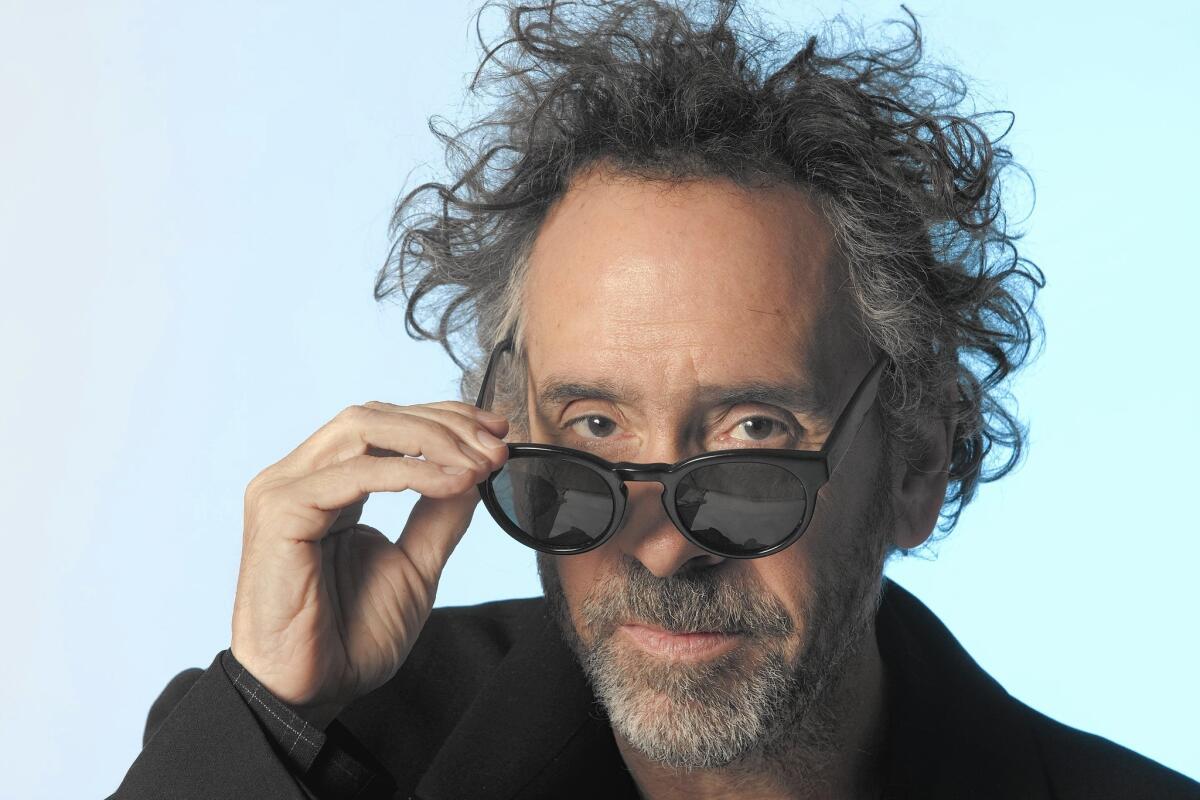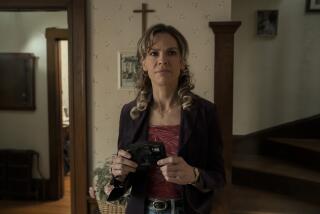‘Big Eyes’ the latest in Tim Burton’s gallery of pop-art portraits

In the early 1990s, long before Tim Burton ever planned to make a movie about Margaret Keane, he traveled to Northern California to commission a portrait from the artist whose paintings of children with oversize, mournful eyes were a nearly inescapable backdrop to 1960s pop culture.
“I went and visited her just because I was a fan,” Burton recalled recently. “The work was very present in the culture I grew up in. There’s something really creepy about it — this may have to do with it being at my grandmother’s house or the doctor’s office.... It was very suburban art. That had impact on me.”
From “Edward Scissorhands” to the stop-motion fantasy “Frankenweenie,” Burton has long displayed a penchant for documenting the horrors and hallmarks of his suburban upbringing in Burbank, channeling his outsider memories into his own unique brand of popular art.
With “Big Eyes,” his new film opening Christmas Day, Burton has crafted a new odd tale, this one rooted in the recent past and so much stranger for having actually transpired. It tells the story of Margaret Keane (Amy Adams), who for years watched her husband, Walter (Christoph Waltz), pass off her paintings as his own.
“Meeting Margaret, her quietness, it must have been really hard [on her],” Burton said in Santa Monica last month, drinking green tea on a hotel lobby sofa. “I just imagine her, this person, going along with it and getting trapped in this weird world.... To me, is there any other kind of relationship than dysfunctional?”
While every marriage has its idiosyncrasies, the dynamic depicted in “Big Eyes” between Margaret and Walter Keane is orders of magnitude more unusual than most. Written by Scott Alexander and Larry Karaszewski, the film opens in 1958 — the year Burton was born — with Margaret leaving one unhappy marriage with her young daughter, Jane, in tow, and landing in Beat-era San Francisco, where she ultimately embarks on another troubled union.
After meeting Walter at an art fair, she finds herself taken in by his romantic tales of painting in Europe, and the pair quickly marry. Soon, her new husband has sweet-talked the proprietor of the hungry i nightclub into displaying their work.
Once her paintings begin to outsell his, however, he convinces Margaret that he should claim credit, that buyers aren’t interested in “women’s art.” She reluctantly agrees, not realizing that the images of the children with the saucer-sized eyes are destined to become fixtures in homes across the country.
“It is a weird [case] of two different people becoming a strange singular thing for a while ... some weird new hybrid life form, Keane, one thing,” Burton said.
The truth about the authorship of the portraits came out once Margaret left Walter, experienced a religious conversion and broke her silence, later taking Walter to court to prove her claims. Despite Margaret’s victory in the proceedings, Walter, who died in 2000, continued to assert that he was the true artist.
Alexander and Karaszewski, the screenwriting duo behind Burton’s Oscar-winning 1994 Hollywood biopic “Ed Wood,” stumbled across the story while researching another film and first approached Margaret about adapting her life story about 11 years ago.
They had long hoped to direct the project themselves, but after Waltz expressed interest in playing Walter early last year, the duo opted to turn the movie over to Burton, who already had signed on to produce.
After a run of recent films that included the $1-billion success of his psychedelic “Alice in Wonderland” and the disappointing returns of his adaptation of the cult TV series “Dark Shadows,” Burton said he’d been looking for a smaller story.
Not only did he have a personal connection to the Keane saga in terms of his familiarity with the art but he also felt a kinship to the characters as written on the page.
“I know for myself, when I was young, I barely spoke,” Burton said. “I just didn’t really communicate. I was always fascinated by people who could talk. It’s very clear who those people are. That yin and yang thing can be a good thing — one person more inward, one more outgoing. Sometimes that works itself out.... It’s like anything, it can have its bad side as well.”
“One of the things people forget about is that Tim’s a painter; Tim is a visual artist,” Karaszewski noted. “He expresses himself through his work. So much of the character of Margaret Keane is nonverbal. She’s a person who can’t speak up. She’s a person who can’t use her voice. She expresses herself through her canvases. I think that’s one of the real, clear ways Tim got into the character.”
The film was shot last summer in Vancouver, Canada — the production traveled to San Francisco only briefly for a few key scenes — and Burton said he found an instant camaraderie with the two stars, neither of whom he’d worked with before. He had especially kind words for Adams, tasked with conveying Margaret’s predicament with little dialogue.
“I love when people can say something without saying something,” Burton said. “It’s like silent movie actors. I love words and everything, but sometimes when you just see people having this internal reaction without really doing anything, I get quite excited about that.”
Alexander said Burton is owed far more credit as an actor’s director than he is typically given.
“Everyone thinks of Tim as the guy whose specialty is wacky stuff with crazy sets and oddball angles and special effects,” he said. “There are so many delightful scenes in ‘Ed Wood’ that are just two guys and a desk in a dingy room because Tim is really terrific with actors. He’s very gentle with them. It’s a very quiet set. He’ll go over to them and just say a couple of words, and he gets wonderful work from them.”
Adams and Waltz certainly have been widely tipped as possible Oscar contenders for their “Big Eyes” performances — this month, the two received Golden Globe nominations for their work in the film. But even with early praise, Burton admitted that the experience of releasing a film was never easy for him.
“You always feel vulnerable when a film comes out,” he said. “It takes me a while to catch my breath and really feel it.... People can be swinging from the rafters, opening up Champagne bottles and cheering, and I wouldn’t really know what was going on.”
He was pleased that Margaret Keane had seemed touched by “Big Eyes,” which Alexander and Karaszewski screened for her well in advance of its commercial release. And he continues to consider himself an admirer of her work.
“I had her commission another painting,” Burton said, “a really nice one.” It’s a portrait of his partner Helena Bonham Carter and their son (the couple also have a daughter). “Ominously, there’s a faint image of me in the clouds. I don’t know if she’s calling me Walter...”
More to Read
Only good movies
Get the Indie Focus newsletter, Mark Olsen's weekly guide to the world of cinema.
You may occasionally receive promotional content from the Los Angeles Times.







